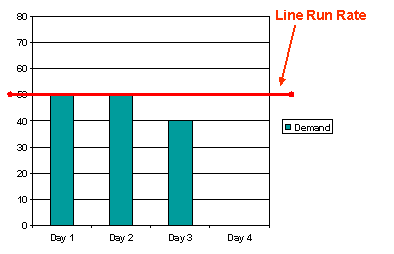
There are three production schedule loading methods in IFS Applications.
Load Infinite
The schedule is loaded considering the line has infinite capacity. Schedules generated using this method meet each demand with an equal supply, regardless of the line rate. This method considers only the quantity and the due date. Jobs are scheduled on the day that the demand occurs.
Example: A production line has demands, as shown below, with a line run rate of 50 units per day. The following graph shows the schedule produced using the Load Infinite method.
| Due Date | Demand |
| Day 1 | 10 |
| Day 2 | 70 |
| Day 3 | 40 |
| Day 4 | 80 |

Forward up to Line Rate
This is a finite scheduling method where the demands are allocated the earliest available time slot, loaded up to the available line rate, and then planned forward to the next day if required. If the completion date is beyond the due date, the schedule will be infeasible.
Example: A production line has demands, as shown below, with a line run rate of 50 units per day. The following graph shows the schedule produced using the Forward Scheduling method. Day 1 is the earliest date available for scheduling.
| Due Date | Demand |
| Day 1 | 0 |
| Day 2 | 0 |
| Day 3 | 0 |
| Day 4 | 140 |

Backward up to Line Rate
This is a finite scheduling method that allocates the latest possible time slot, loaded up to the line rate, and then planned backward from the due date to a previous day as required. If the required start date has already passed, the schedule will not be feasible. If the demand quantity exceeds the available line rate, the excess demand is accumulated on the first day after the production line's firm horizon date, even if it exceeds the line rate.
| Due Date | Demand |
| Day 1 | 0 |
| Day 2 | 0 |
| Day 3 | 0 |
| Day 4 | 140 |
